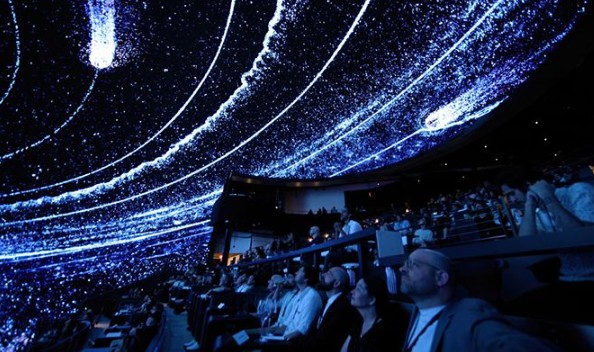As audiovisual (AV) technologies evolve rapidly, the industry is experiencing a major shift—from traditional flat screens to fully immersive LED environments. These changes are driven by audience demand for immersive experiences, real-time content delivery, and increasingly interactive AV systems. LED domes, curved displays, and wraparound LED walls are transforming how we tell stories, share data, and design physical spaces.

This article explores what’s driving this transition, the technologies making it possible, real-world case studies, and what it means for integrators, content creators, and architects looking to stay ahead.
For decades, flat panels have dominated AV installations—digital signage, boardrooms, broadcast sets, and public displays. But flat panels are inherently limited in field of view and spatial immersion.
Immersive LED environments change that. By wrapping visuals around the viewer, curved LED walls and full LED domes create a sense of depth, motion, and interaction that flat panels can’t replicate. This opens the door for powerful new storytelling and data visualization techniques.
AV systems are no longer just about displaying information—they’re about delivering spatial experiences.
Immersive experiences drive engagement. In settings like theme parks, science museums, esports arenas, and XR studios, viewers don’t just watch—they become part of the environment.
When content is delivered across a 180° or 360° dome, the brain interprets it as a real-world spatial experience. This enhances emotional impact, memory retention, and brand connection.
As AV technologies become more affordable and powerful, immersive display systems are moving beyond niche attractions and into mainstream corporate, retail, and educational environments.
Several innovations are making immersive LED systems more accessible and scalable:
COB and MicroLED displays: These allow for ultra-fine pixel pitches and smoother curves, enabling seamless full-dome visuals.
High-refresh-rate LED modules: Paired with low-latency control systems, they support real-time camera tracking and XR production.
AI-driven calibration tools: Used for edge blending, brightness matching, and auto color correction across complex screen geometries.
Real-time content engines: Platforms like Unreal Engine, Disguise, and Notch enable dynamic generative content adapted to LED surfaces.
Durable, high-performance LEDs: Reliable LED packages—such as Kinglight’s wide-color-gamut SMD solutions—ensure color consistency and longevity, even under extreme operating conditions.
Let’s explore how these ideas are coming to life:
The world’s largest LED dome, featuring over 1.2 million LED pucks, covers both the interior and exterior in programmable visuals. With immersive audio and 360° visuals, the venue redefines what an entertainment experience looks like.
Purpose-built for immersive sports, science, and branded events, these 20+ meter domes use ultra-fine-pitch LED panels to deliver real-time visuals driven by interactive content engines.
Across film and broadcast, LED stages with curved walls, ceilings, and even LED floors are replacing green screens. They offer real-time parallax and lighting realism, essential for high-end virtual production.
Installations like ARTECHOUSE and Nike House of Innovation use immersive domes and tunnels to combine physical movement with interactive storytelling, enhancing product discovery and visitor engagement.
Why are so many industries embracing curved LED displays and domes?
Enhanced Engagement: Full-field visuals increase viewer attention and dwell time.
Stronger Emotional Response: Dome environments deliver a more visceral and memorable impact.
360° Storytelling: Creators can lead audiences through time, space, or narrative arcs using spatial media.
Better Data Visualization: In simulation, defense, or scientific research, wrapping data around a user boosts spatial understanding.
These benefits aren’t just visual—they impact business outcomes, from brand loyalty to learning retention.
Adopting immersive AV systems requires careful planning. Common hurdles include:
Cost and ROI: LED domes can be expensive upfront. A strong content and monetization strategy is key.
Thermal Management: Heat dissipation is more complex with enclosed, curved LED surfaces.
Custom Content Creation: Storytelling must be adapted for immersive formats, using tools like dome-mapped rendering and spatial audio.
Structural Engineering: Domes require precise fabrication and load planning to ensure safety and alignment.
Successful deployments involve early coordination between AV integrators, architects, LED manufacturers, and creative teams.
Looking ahead, we see immersive AV systems becoming more modular, wireless, and AI-enhanced. Trends include:
Portable domes and foldable LED panels for pop-up venues
Cloud-controlled AV systems for remote updates and monitoring
Audience-aware content using motion sensors and real-time adaptation
Green AV systems that reduce power consumption and material waste
As AV becomes more embedded into architecture and environments, immersive LED displays will no longer be “special features”—they will be expected parts of the experience.
We’re entering an era where screens are no longer just rectangles on walls—they are the walls. Immersive LED domes and curved displays represent a new paradigm in AV system design: one that blends storytelling, architecture, and emotion.
For integrators, designers, and creators, now is the time to explore this transformation. With the right technology—such as Kinglight’s high-performance LED components—you can build visual environments that don’t just display content… they shape immersive experiences that leave a lasting impact.